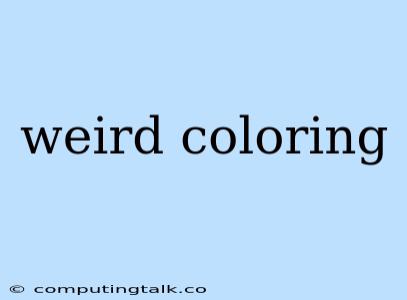Weird Coloring: Exploring the Unconventional and Unexpected
Have you ever stumbled upon a piece of art that made you tilt your head in confusion, wondering "what in the world is going on here?" Perhaps you've seen a painting with colors that clash wildly, or a photograph where the hues seem to dance in a bizarre harmony. This is the realm of weird coloring, a captivating realm where artists challenge traditional norms and embrace the unconventional.
Weird coloring isn't just about being bizarre for the sake of it. It's a deliberate choice, often driven by a desire to express emotions, ideas, or perspectives that defy easy categorization. Artists who explore weird coloring might be drawn to the abstract, the surreal, or the unsettling. They might be interested in pushing the boundaries of what's considered "acceptable" in terms of color combinations and palettes.
Why is weird coloring so compelling?
There's something undeniably captivating about weird coloring. It challenges our expectations and forces us to reconsider our assumptions about how colors should be used. It can evoke a sense of wonder, intrigue, and even unease.
Here are some reasons why weird coloring might appeal to you:
- It challenges your perception: By using unexpected color combinations, weird coloring can force you to see the world in a new light. It can make you question your preconceived notions about what colors "should" look like together.
- It evokes emotions: Colors have a powerful ability to evoke emotions, and weird coloring can tap into this power in a unique way. By using colors that are unexpected or jarring, artists can create a sense of unease, excitement, or even joy.
- It's a form of self-expression: Weird coloring can be a powerful way for artists to express themselves. It allows them to break free from conventional norms and explore their own unique vision.
Examples of weird coloring in art:
- Surrealism: Surrealist artists often used weird coloring to create dreamlike and illogical scenes. Think of the work of Salvador Dalí, where colors are used in unexpected ways to create a sense of disorientation and fantasy.
- Abstract Expressionism: Abstract Expressionist painters like Jackson Pollock and Willem de Kooning used weird coloring to explore the subconscious mind and the power of raw emotion. Their paintings often feature vibrant, clashing colors that create a sense of chaos and energy.
- Contemporary art: Contemporary artists continue to explore weird coloring in a variety of ways. Some artists use digital tools to create manipulated images with unusual color palettes, while others use traditional mediums like paint and canvas to create abstract and expressive works.
How can you explore weird coloring in your own art?
- Embrace the unexpected: Don't be afraid to experiment with color combinations that you might normally avoid. Try mixing colors that you wouldn't think would work together.
- Look at your subject matter: The subject matter of your art can influence your color choices. If you're painting a landscape, you might use muted colors to create a sense of realism. But if you're painting a portrait, you might use brighter, more saturated colors to capture the personality of the subject.
- Use color theory as a guide: While you're encouraged to break the rules, it's still helpful to understand basic color theory. This will help you make informed decisions about your color choices and how they will impact the overall look and feel of your art.
Weird coloring is a testament to the boundless possibilities of art. It's a reminder that there's no one right way to use color and that sometimes, the most compelling works are the ones that defy expectations and challenge our perceptions. So, embrace the weird, experiment with color, and let your creativity flow!
